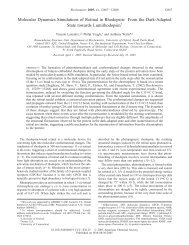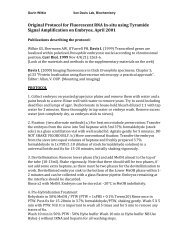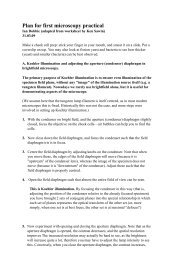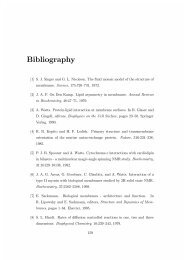Fluorescent Dyes and Proteins - Department of Biochemistry
Fluorescent Dyes and Proteins - Department of Biochemistry
Fluorescent Dyes and Proteins - Department of Biochemistry
You also want an ePaper? Increase the reach of your titles
YUMPU automatically turns print PDFs into web optimized ePapers that Google loves.
<strong>Fluorescent</strong> <strong>Dyes</strong> <strong>and</strong> <strong>Proteins</strong><br />
Mark Howarth<br />
Lecturer in Bionanotechnology<br />
<strong>Department</strong> <strong>of</strong> <strong>Biochemistry</strong><br />
1
Overview<br />
1. What kind <strong>of</strong> structures are fluorescent<br />
2. How to make <strong>and</strong> target fluorescent probes<br />
3. <strong>Fluorescent</strong> probes for cellular structure <strong>and</strong> function<br />
4. Using light to control cells<br />
2
Not all energy emitted as fluorescence<br />
Fluorescence<br />
(10 -9 s)<br />
Absorption<br />
(10 -15 s)<br />
FRET<br />
Internal<br />
conversion<br />
Triplet state<br />
Phosphorescence<br />
(10 2 - 10 -2 s)<br />
Quantum yield = no. <strong>of</strong> fluorescent photons emitted<br />
no. <strong>of</strong> photons absorbed<br />
e.g. EGFP QY=0.6 For every 10 photons absorbed, 6 are emitted.<br />
(at optimal temp, pH etc.)<br />
3
What sort <strong>of</strong> molecules are<br />
fluorescent?<br />
Organic fluorophores<br />
especially<br />
1. Intrinsic fluorophores (source <strong>of</strong> aut<strong>of</strong>luorescence)<br />
2. <strong>Dyes</strong><br />
3. <strong>Fluorescent</strong> proteins<br />
Inorganic fluorophores<br />
especially<br />
1. Lanthanides<br />
2. Quantum dots<br />
4
What sort <strong>of</strong> molecules are fluorescent?<br />
1. Organic fluorophores<br />
Chemical features:<br />
1. Conjugation<br />
2. Rigidity especially fused aromatic rings<br />
3. Heteroatoms<br />
5
Please rank these in order<br />
<strong>of</strong> fluorescence<br />
2<br />
6
What sort <strong>of</strong> molecules are fluorescent?<br />
1. Endogenous organic fluorophores<br />
Most common aut<strong>of</strong>luorescent molecules:<br />
Flavins, NADH, NADPH, elastin, collagen, lip<strong>of</strong>uscin<br />
Avoiding aut<strong>of</strong>luorescence:<br />
choose dye emitting in red with big Stokes shift<br />
add quencher (Crystal violet)<br />
add reducing agent to react with aut<strong>of</strong>luorescent molecules<br />
time-gate fluorescence<br />
7
What sort <strong>of</strong> molecules are fluorescent?<br />
2. Inorganic fluorophores<br />
Lanthanides Quantum dots<br />
Peptide sequence<br />
binds Tb 3+ <strong>and</strong> protects<br />
from quenching by water<br />
Passivating layer<br />
ZnS coat<br />
CdSe core<br />
Curr Opin Chem Biol. 2010;14(2):247-54.<br />
Lanthanide-tagged proteins--an illuminating<br />
partnership. Allen KN, Imperiali B.<br />
Michalet X, et al. Quantum dots for live cells, in<br />
vivo imaging, <strong>and</strong> diagnostics. Science. 2005<br />
307(5709):538-44.<br />
8
How good is a fluorophore?<br />
Green dye<br />
1. Excitation <strong>and</strong> emission appropriate<br />
self-quenching<br />
background worse in UV + with small Stokes shift<br />
good match to filters on your microscope<br />
look at other fluorophores at same time<br />
2. Bright<br />
see small numbers <strong>of</strong> fluorophores,<br />
low self-quenching, high QY <strong>and</strong> absorbance<br />
3. Stable to photobleaching<br />
exciting light damages fluorophore<br />
4. Non-toxic<br />
5. Environment-insensitive (especially to pH)<br />
6. Little non-specific binding<br />
7. Small<br />
8. Little blinking<br />
(9. Cost)<br />
Fluorescein pH sensitivity<br />
9
Alexa Fluor 488 vs Fluorescein Bleaching<br />
2x Real Time<br />
10
Alexa Fluor <strong>Dyes</strong> – Photostability<br />
Laser-scanning<br />
cytometry<br />
EL4 cells<br />
biotin-anti-CD44<br />
+ streptavidin<br />
conjugates<br />
Fluorescein is the commonest dye<br />
but has poor photostability.<br />
Also consider Atto dyes (Sigma) <strong>and</strong> Dyomics dyes<br />
11
Protecting the fluorescence signal -<br />
Antifade Reagents for fixed cells<br />
Scavenge <strong>and</strong> prevent reactive oxygen species from forming.<br />
For fixed cells:<br />
Home made: 0.3% p-phenylene-diamine (Sigma)<br />
or Propyl Gallate<br />
Vectashield: Proprietary, very effective all round, affects psf<br />
Dabco<br />
Prolong Gold ®<br />
+ Prolong Gold<br />
Untreated<br />
12
Antifade Reagents for Live Cells<br />
HO<br />
H 3<br />
C<br />
Trolox<br />
CH 3<br />
O<br />
C OH<br />
O CH 3<br />
CH 3<br />
-Trolox<br />
+Trolox<br />
Blinking <strong>of</strong> single molecule <strong>of</strong> Atto647N on DNA,<br />
Vogelsang Tinnefeld Ang Chem 2008<br />
• Trolox is an antioxidant that<br />
can reduce bleaching<br />
compatible with live specimens<br />
water-soluble<br />
working conc. ~100 µM<br />
• Ascorbic acid is an alternative<br />
antioxidant<br />
• Depleting oxygen (especially<br />
used for some single molecule<br />
experiments) with Glucose<br />
Oxidase <strong>and</strong> Catalase greatly<br />
reduces bleaching.<br />
• Can stop not only bleaching<br />
but also blinking<br />
13
Microsecond! fluorescent measurements<br />
with Trolox + cysteamine<br />
Oxygen helps stop triplet-state build-up<br />
BUT oxygen promotes photobleaching<br />
For rapid photon cycling-<br />
1. leave oxygen in<br />
2. add Trolox to further quench triplet state<br />
3. include cysteamine (a thiol) to protect<br />
from singlet oxygen <strong>and</strong> hydroxyl radicals<br />
Green/Red Alexa dye FRET<br />
on rapid folding protein V. Munoz Nat Meth 2011<br />
14
Multiplexing- four main colours<br />
Excitation<br />
wavelengths:<br />
350 488 555 647<br />
Emission<br />
wavelengths:<br />
Blue green orange/red far f<br />
red<br />
350 400 450 500 550 600 650 700<br />
DAPI/UV<br />
FITC<br />
TRITC<br />
FAR RED<br />
Alexa Fluor ® 350<br />
Coumarin, , AMCA<br />
Alexa Fluor ® 488<br />
Fluorescein (FITC)<br />
Cy2<br />
Alexa Fluor ® 555<br />
Rhodamine,<br />
TAMRA, TRITC<br />
Cy3<br />
Alexa Fluor ® 647<br />
Cy5, APC<br />
Alexa Fluor ® 594<br />
Texas Red, Cy3.5<br />
Colour Selection ♦<br />
Brightness ♦<br />
Photostability<br />
15
Overview<br />
1. What kind <strong>of</strong> structures are fluorescent<br />
2. How to make <strong>and</strong> target fluorescent probes<br />
3. <strong>Fluorescent</strong> probes for cellular structure <strong>and</strong> function<br />
4. Using light to control cells<br />
16
Major bottleneck to using new probes<br />
is difficulty targeting them<br />
GFP<br />
X<br />
GFP<br />
X<br />
photoaffinity<br />
probes<br />
fluorescent proteins<br />
easy to target<br />
quantum<br />
dots<br />
?<br />
organic<br />
fluorophores<br />
other probes hard<br />
to target<br />
17
Antibodies for cellular imaging<br />
Live cells<br />
Label plasma membrane <strong>and</strong> secretory pathway<br />
Penetrate plasma membrane<br />
(microinjection, electroporation, pinosome lysis, streptolysin,<br />
cell permeable peptides, ester cage)<br />
Get dynamics, avoid fixation artifacts<br />
Fixed cells<br />
Permeabilise<br />
Still can give enormous amount <strong>of</strong> useful information<br />
18
Not just antibodies for targeting<br />
Other types <strong>of</strong> targeting agents:<br />
<strong>Proteins</strong><br />
(especially antibodies, but also transferrin, insulin, EGF etc.)<br />
Peptides (MHC class I pathway, proteasome function)<br />
RNA (mRNA, molecular beacons, aptamers, siRNA)<br />
DNA<br />
lipids, lipoproteins<br />
drugs<br />
?<br />
19
How to dye: it is easy<br />
Multiple ways to modify proteins<br />
(see Molecular Probes catalogue)<br />
Most common ways are to modify:<br />
1. Lysine<br />
or<br />
Protein target<br />
NHS-dye Amide bond<br />
to dye<br />
2. Cysteine<br />
maleimide-dye Thioether bond<br />
to dye<br />
A Add dye to protein for 3 hr<br />
B 1cm Sephadex column to remove most free dye (10 min)<br />
C Dialyse away rest <strong>of</strong> free dye (24 hr)<br />
20
Site-specific protein labelling methods<br />
1. Binding domain<br />
SNAP-tag (NEB), HaloTag (Promega)<br />
2. Binding peptide<br />
FlAsH (Invitrogen)<br />
3. Enzymatic ligation to peptide<br />
PRIME<br />
AY Ting PNAS 2010<br />
Chen & Ting, Curr. Opin. Biotech. 2005<br />
21
Overview<br />
1. What kind <strong>of</strong> structures are fluorescent<br />
2. How to make <strong>and</strong> target fluorescent probes<br />
3. <strong>Fluorescent</strong> probes for cellular structure <strong>and</strong> function<br />
4. Using light to control cells<br />
22
Putting the signal in context: nuclear labelling<br />
(follow DNA even when<br />
nucleus breaks down)<br />
Fixed cells:<br />
Intercalate into DNA<br />
DAPI<br />
(well away from other channels)<br />
Hoechst 33342<br />
Live cells:<br />
histone H2B-GFP<br />
23
Endoplasmic Reticulum<br />
ER-Tracker Blue-White DPX<br />
antibody to calnexin<br />
Brefeldin A-BODIPY® 558 conjugate<br />
Live cells: ss-GFP-KDEL<br />
24
Mitochondria<br />
Fixed cells: anti–cytochrome oxidase subunit I Ab<br />
Live cells: MitoTracker® Red/Green/Orange<br />
CMTMRos<br />
JC-1 (red J-aggregates at high conc., red to green<br />
depends on membrane potential)<br />
Mitochondrial targeting sequence-GFP<br />
25
Lysosomes<br />
Fixed cells: anti-LAMP1<br />
Live cells: LysoTracker® Red /Green (weakly basic amines can accumulate in lysosomes)<br />
LysoSensor Yellow/Blue DND-160, LAMP1-GFP<br />
26
Lipid Rafts<br />
BODIPY® FL C 5 -ganglioside GM1<br />
<strong>Fluorescent</strong> Cholera Toxin subunit B (CT-B)<br />
27
Putting the signal in context: actin labelling<br />
Fixed cells: phalloidin-dye<br />
Live cells:<br />
Lifeact-GFP (17 aa peptide binding actin)<br />
28
Cytosol<br />
Live cells:<br />
CellTracker Green CMFDA<br />
Calcein, , AM<br />
Qtracker<br />
GFP with nuclear export sequence<br />
29
The breakthrough <strong>of</strong> fluorescent proteins<br />
from jellyfish<br />
Aequorea<br />
victoria<br />
Osamu<br />
Shimomura<br />
How much did he need?<br />
30
The breakthrough <strong>of</strong> fluorescent proteins<br />
for live cell imaging<br />
Green<br />
<strong>Fluorescent</strong><br />
Protein<br />
GFP fold<br />
β-can<br />
GFP chromophore<br />
from Ser-Tyr-Gly<br />
GFP<br />
X<br />
GFP<br />
X<br />
Link GFP sequence to gene <strong>of</strong><br />
your favourite protein<br />
GFP folds<br />
<strong>and</strong> becomes<br />
fluorescent<br />
GFP lights up your<br />
favourite protein in cell<br />
31
<strong>Fluorescent</strong> proteins are<br />
more than just labels<br />
Photoactivation/Photoswitching<br />
PA-GFP, Dronpa, Eos<br />
Reporting on environment<br />
Ca 2+ , phosphorylation, cAMP, cGMP, pH,<br />
neurotransmitters, voltage, cell cycle, redox<br />
Reporting on protein-protein interaction<br />
CFP/YFP FRET, split fluorescent proteins<br />
Modifying environment<br />
Singlet oxygen generation, Channelrhodopsin<br />
Targeting<br />
advantage<br />
to defined<br />
compartment,<br />
cell-type,<br />
developmental<br />
stage<br />
32
Chromophores in switching<br />
Green<br />
<strong>Fluorescent</strong><br />
Protein<br />
PA-GFP, PS-CFP2<br />
GFP fold<br />
β-can<br />
Dendra, Eos<br />
Link GFP sequence to gene <strong>of</strong><br />
your favourite protein<br />
GFP folds<br />
<strong>and</strong> becomes<br />
fluorescent<br />
Dronpa<br />
33
Sensing voltage with<br />
fluorescent protein<br />
Mermaid FRET voltage-sensor<br />
by FP fusion to voltage-sensing phosphatase<br />
Expressed in zebrafish heart<br />
Non-invasive testing <strong>of</strong> mutant phenotypes<br />
<strong>and</strong> drug cardiotoxicity.<br />
Tsutsui, Miyawaki J Physiol 2010<br />
N.B. FRET sensor ratio crucial best is YC2.60 cameleon: 600%,<br />
if
Small molecule fluorescent sensors<br />
Fura-2 sensing calcium<br />
Metal ions: calcium, magnesium, zinc, sodium, potassium, chloride,<br />
mercury<br />
pH (also dyes to conjugate to proteins, CyPher from GE, SNARF from<br />
Invitrogen)<br />
Reactive oxygen species, nitric oxide<br />
Transmembrane potential<br />
35
Why use small molecule rather than<br />
genetically-encoded probes?<br />
1. No need to transfect<br />
hard for some organisms <strong>and</strong><br />
primary cells<br />
easier to titrate<br />
potential clinical applicatione.g.<br />
image-guided surgery<br />
MMP-activated Cy5 peptide<br />
labels tumour (RY Tsien 2010)<br />
2. Probes <strong>of</strong>ten brighter, with bigger signal to noise<br />
struggle to make GFP-based calcium reporter as good<br />
as fura-like dyes<br />
3. Probes with entirely different fluorescent properties<br />
QD photostability, probes with long<br />
fluorescence lifetimes, photouncaging<br />
4. Smaller<br />
e.g. calcium conc. right next to pore <strong>of</strong> ion channel<br />
36
How good is a fluorescent protein?<br />
A. victoria GFP is good for jellyfish,<br />
but not great for cell biologists!<br />
37
How good is a fluorescent protein?<br />
A. victoria GFP is terrible!<br />
EGFP is OK, but there are now better...<br />
1. Excitation <strong>and</strong> emission λ good match to filters on your microscope<br />
look at other fluorophores at same time<br />
2. Bright ε x QY Clover, YPet 2.5 x EGFP<br />
mRuby2 3x mCherry<br />
3. Stable to photobleaching EBFP bad, mCherry <strong>and</strong> YPet good<br />
4. Non-toxic attach on right part <strong>of</strong> your protein<br />
all make H 2<br />
O 2<br />
, FPs can transfer electrons<br />
5. Environment-insensitive especially to pH, chloride<br />
CyPet does not fold at 37°C, all need O 2<br />
Photoactivatable FP did not work in ER<br />
6. Little non-specific binding fully monomeric, A206K non-dimerising<br />
7. Fast Maturation Venus 2 min. Red FPs can start <strong>of</strong>f green!<br />
half-time ~15 min mCherry, 100 min TagRFP<br />
38
You MUST worry about FP<br />
multimerization!<br />
Tag multimerizing protein with FP <strong>and</strong><br />
sometimes see fociare<br />
these real or caused by the tag?<br />
With hexameric barrel involved in<br />
E. coli protein degradation,<br />
many commonly used FPs induce<br />
artifactual foci<br />
(no cluster with Ab or SNAP-Tag)<br />
as well as affecting daughter cell<br />
inheritance <strong>of</strong> proteolysis ability<br />
mCherry, sfGFP, mYPet poor!<br />
mGFPmut3, Dronpa OK<br />
D. L<strong>and</strong>graf et al. Nature Meth 2012<br />
39
Problems with GFP in cells<br />
• GFP with light can donate electrons<br />
to different acceptors<br />
(FMN, FAD, NAD + , cyt. c)<br />
GFP reddens after transfer:<br />
photobleaching <strong>and</strong> phototoxicity<br />
use DMEM lacking e - acceptors<br />
(rib<strong>of</strong>lavin or all vitamins) for less bleaching<br />
(HEK 293T happy for 1 week)<br />
effect for EGFP <strong>and</strong> PA-GFP, not RFPs<br />
Lukyanov Nat Meth 2009<br />
• EGFP not good in secretory pathway<br />
mixed disulfide oligomers in ER <strong>and</strong><br />
non-fluorescent in E. coli periplasm<br />
(superfolder GFP behaves fine)<br />
Erik Snapp, Traffic 2011<br />
40
<strong>Fluorescent</strong> RNA imaging<br />
See single mRNA: MS2 mRNA stem-loops bound by MCP-YFP<br />
See product <strong>of</strong> translation: mRNA encodes CFP-SKL which goes to peroxisomes<br />
MCP-YFP<br />
S.M.Janicki et al. Cell 2004<br />
Spinach RNA 60 nt aptamer binds cell-permeable fluorogenic dye<br />
Photostable. Used to label 5S RNA in HEK cells. Samie Jaffrey Science 2011<br />
41
Overview<br />
1. What kind <strong>of</strong> structures are fluorescent<br />
2. How to make <strong>and</strong> target fluorescent probes<br />
3. <strong>Fluorescent</strong> probes for cellular structure <strong>and</strong> function<br />
4. Using light to control cells<br />
42
Why use light to control biology?<br />
Light control allows extreme<br />
temporal <strong>and</strong> spatial control.<br />
Temporal control<br />
genes< chemicals < light<br />
min-hr s-min µs-s<br />
Spatial control<br />
chemicals / genes < light (note micropipettes for precise<br />
one or many cells 1 μm part <strong>of</strong> cell small molecule delivery)<br />
(<strong>of</strong>ten combine chemical/light control or gene/light control)<br />
optogenetics/chemogenetics<br />
Limitations <strong>of</strong> light? $$$$$<br />
<strong>and</strong> usually data on one cell at a time
Controlling biology with light:<br />
light-gated ion channels<br />
Channelrhodopsin from an alga, like rhodopsin, undergoes retinal isomerisation<br />
in response to light, <strong>and</strong> changes conformation, but opens a Na + channel.<br />
This allows light to control membrane voltage <strong>and</strong> trigger neuron firing.<br />
to underst<strong>and</strong> neuronal firing patterns<br />
to control secretion in diabetes<br />
potentially in fixing neural diseases?<br />
e.g. damping down overactivity in<br />
epilepsy<br />
trains <strong>of</strong> electrical firing<br />
flashes <strong>of</strong> light<br />
44
LOV domains react <strong>and</strong> switch<br />
conformation with light<br />
LOV domains:<br />
light, oxygen, voltage responders<br />
ones responding to blue light in bacteria, plants <strong>and</strong> fungi<br />
FMN c<strong>of</strong>actor<br />
present in all cells.<br />
Light polarises to increase<br />
reactivity to Cys attack.<br />
New pattern <strong>of</strong><br />
protein-protein<br />
interaction...
Genetically-encoded photoactivation<br />
458 or 473nm light<br />
spontaneous<br />
reversion at RT<br />
t1/2 43s for<br />
1. Constitutively active Rac mutant<br />
2. Optimise LOV-Rac junction,<br />
3. knockout GTP hydrolysis <strong>and</strong> GAP/GNDI/GEF interactions<br />
K d<br />
for PAK 2 μM in dark, 200nM in light 10-fold ratio<br />
Interaction <strong>of</strong> Rac with PAK stimulates cell protrusion <strong>and</strong> migration.<br />
K.Hahn et al. Nature Sept. 2009
Correlated Light Microscopy/<br />
Electron Microscopy<br />
MiniSOG (Shu, Tsien PLoS Biol 2011)<br />
Light causes generation <strong>of</strong> singlet oxygen-> DAB polymerized-> binds OsO 4<br />
106 aa monomer, engineered from Arabidopsis LOV domain<br />
tested in cell-lines, worms <strong>and</strong> transgenic mice<br />
Overcomes trade-<strong>of</strong>f between thorough fixation <strong>and</strong> penetration <strong>of</strong> labeling reagent<br />
(Also see APEX protein tag for DAB for EM staining, JD Martell et al. Nat Biotech 2012)
Conclusions<br />
Choosing the right dye or fluorescent protein<br />
can make a big difference for:<br />
sensitivity<br />
signal stability<br />
modification to molecule/cell function<br />
by size or multimerization<br />
<strong>Fluorescent</strong> probes allow more than<br />
just following location:<br />
reporting cellular events<br />
uncaging biomolecule function<br />
controlling interactions <strong>and</strong> ion flux<br />
48
References<br />
Fluorescence probes<br />
Molecular Probes H<strong>and</strong>book, free from Invitrogen.<br />
Principles <strong>of</strong> Fluorescence Spectroscopy 2 nd edition,<br />
by Joseph R. Lakowicz.<br />
Protein modification<br />
Bioconjugate Techniques, 2 nd Edition<br />
by Greg T. Hermanson.<br />
Chemical labeling strategies for cell biology, Marks<br />
KM, Nolan GP. Nat Methods. 2006 Aug;3(8):591-6.<br />
<strong>Fluorescent</strong> proteins<br />
(i) as labels: Nat Methods. 2012;9:1005-12. Improving<br />
FRET dynamic range with bright green <strong>and</strong> red<br />
fluorescent proteins. Lam AJ et al.<br />
Poster:<br />
http://www.nature.com/nrm/posters/fluorescent/index.html<br />
(ii) as sensors: Designs <strong>and</strong> applications <strong>of</strong><br />
fluorescent protein-based biosensors.<br />
Ibraheem A, Campbell RE.<br />
Curr Opin Chem Biol 2010;14:30-6<br />
49







